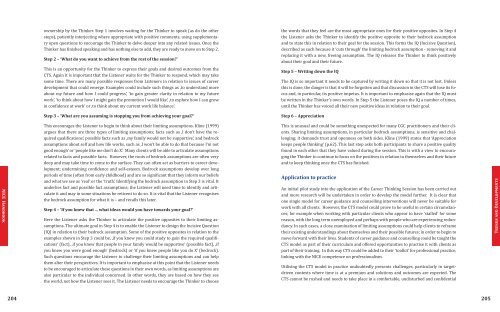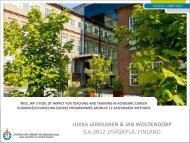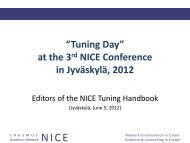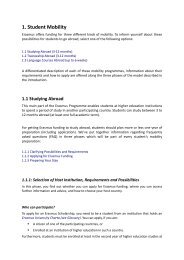NICE HANDBOOK â Academic training of Career ... - Nice-network.eu
NICE HANDBOOK â Academic training of Career ... - Nice-network.eu
NICE HANDBOOK â Academic training of Career ... - Nice-network.eu
You also want an ePaper? Increase the reach of your titles
YUMPU automatically turns print PDFs into web optimized ePapers that Google loves.
ownership by the Thinker. Step 1 involves waiting for the Thinker to speak (as do the othersteps), patiently interjecting where appropriate with positive comments, using supplementaryopen questions to encourage the Thinker to delve deeper into any related issues. Once theThinker has finished speaking and has nothing else to add, they are ready to move on to Step 2.Step 2 – ‘What do you want to achieve from the rest <strong>of</strong> the session?’the words that they feel are the most appropriate ones for their positive opposites. In Step 4the Listener asks the Thinker to identify the positive opposite to their bedrock assumptionand to state this in relation to their goal for the session. This forms the IQ (Incisive Question),described as such because it ‘cuts through’ the limiting bedrock assumption - removing it andreplacing it with a new, freeing assumption. The IQ releases the Thinker to think positivelyabout their goal and their future.This is an opportunity for the Thinker to express their goals and desired outcomes from theCTS. Again it is important that the Listener waits for the Thinker to respond, which may takesome time. There are many possible responses from Listeners in relation to issues <strong>of</strong> careerdevelopment that could emerge. Examples could include such things as ‚to understand moreabout my future and how I could progress’, ‘to gain greater clarity in relation to my futurework’, ‘to think about how I might gain the promotion I would like‘, ‚to explore how I can growin confidence at work‘ or ‚to think about my current work life balance‘.Step 5 – Writing down the IQThe IQ is so important it needs to be captured by writing it down so that it is not lost. Unlessthis is done, the danger is that it will be forgotten and that discussion in the CTS will lose its focusand, in particular, its positive impetus. It is important to emphasise again that the IQ mustbe written in the Thinker’s own words. In Step 5 the Listener poses the IQ a number <strong>of</strong> times,until the Thinker has voiced all their new positive ideas in relation to their goal.Step 3 – ‘What are you assuming is stopping you from achieving your goal?’Step 6 – Appreciation<strong>NICE</strong> HandbookThis encourages the Listener to begin to think about their limiting assumptions. Kline (1999)argues that there are three types <strong>of</strong> limiting assumptions; facts such as ‚I don’t have the requiredqualifications‘, possible facts such as ‚my family would not be supportive‘, and bedrockassumptions about self and how life works, such as ‚I won’t be able to do that because I‘m notgood enough‘ or ‘people like me don’t do X’. Many clients will be able to articulate assumptionsrelated to facts and possible facts. However, the roots <strong>of</strong> bedrock assumptions are <strong>of</strong>ten verydeep and may take time to come to the surface. They can <strong>of</strong>ten act as barriers to career development;undermining confidence and self-esteem. Bedrock assumptions develop over longperiods <strong>of</strong> time (<strong>of</strong>ten from early childhood) and are so significant that they inform our beliefsand what we see as ‘real’ or the ‘truth’. Identifying the bedrock assumption in Step 3 is vital. Itunderlies fact and possible fact assumptions; the Listener will need time to identify and articulateit and may in some situations be reticent to do so. It is vital that the Listener recognisesthe bedrock assumption for what it is – and recalls this later.Step 4 – ‘If you knew that ... what ideas would you have towards your goal?’Here the Listener asks the Thinker to articulate the positive opposites to their limiting assumptions.The ultimate goal in Step 4 is to enable the Listener to design the Incisive Question(IQ) in relation to their bedrock assumption. Some <strong>of</strong> the positive opposites in relation to theexamples shown in Step 3 could be, ‚if you knew you could study to gain the required qualifications‘(fact), ‚if you knew that people in your family would be supportive‘ (possible fact), ‚ifyou knew you were good enough‘ (bedrock) or ‘if you knew people like you do X’ (bedrock).Such questions encourage the Listener to challenge their limiting assumptions and can helpthem alter their perspectives. It is important to emphasise at this point that the Listener needsto be encouraged to articulate these questions in their own words, as limiting assumptions arealso particular to the individual concerned. In other words, they are based on how they seethe world, not how the Listener sees it. The Listener needs to encourage the Thinker to chooseThis is unusual and could be something unexpected for many CGC practitioners and their clients.Sharing limiting assumptions, in particular bedrock assumptions, is sensitive and challenging;it demands trust and openness on both sides. Kline (1999) states that ‘Appreciationkeeps people thinking’ (p.62). This last step asks both participants to share a positive qualityfound in each other that they have valued during the session. This is with a view to encouragingthe Thinker to continue to focus on the positives in relation to themselves and their futureand to keep thinking once the CTS has finished.Application to practiceAn initial pilot study into the application <strong>of</strong> the <strong>Career</strong> Thinking Session has been carried outand more research will be undertaken in order to develop the model further. It is clear thatone single model for career guidance and counselling interventions will never be suitable forwork with all clients. However, the CTS model could prove to be useful in certain circumstances;for example when working with particular clients who appear to have ‘stalled’ for somereason, with the long term unemployed and perhaps with people who are experiencing redundancy.In such cases, a close examination <strong>of</strong> limiting assumptions could help clients to reframetheir existing understandings about themselves and their possible futures; in order to begin tomove forward with their lives. Students <strong>of</strong> career guidance and counselling could be taught theCTS model as part <strong>of</strong> their curriculum and <strong>of</strong>fered opportunities to practise it with clients aspart <strong>of</strong> their <strong>training</strong>. In this way CTS could be added to their ‘toolkit’ for pr<strong>of</strong>essional practice,linking with the <strong>NICE</strong> competence on pr<strong>of</strong>essionalism.Utilising the CTS model in practice undoubtedly presents challenges, particularly in targetdrivencontexts where time is at a premium and solutions and outcomes are expected. TheCTS cannot be rushed and needs to take place in a comfortable, undisturbed and confidentialTrends and Developments204 205






